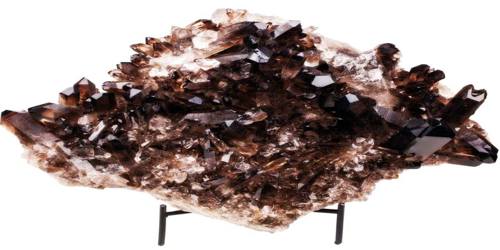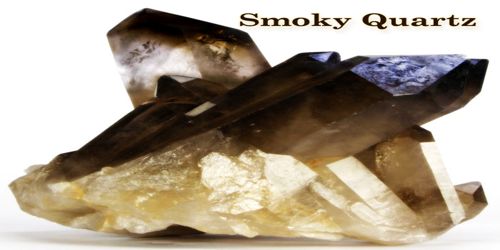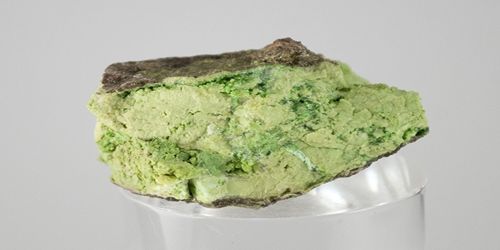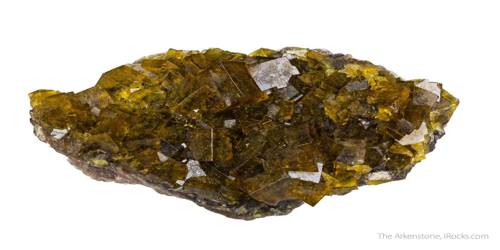Definition –
Smoky Quartz is a color-variety of crystalline quartz. It is a grey, translucent variety of quartz that ranges in clarity from almost complete transparency to an almost-opaque brownish-gray or black crystal. It ranges from a light yellowish-brown to a brown that is so dark that it appears to be black. Less-desirable specimens have a grayish-brown color. When cut as a gem, stones with an orangish-brown to a reddish-brown color are preferred by many people.
Like other quartz gems, it is a silicon dioxide crystal. The smoky color results from free silicon formed from the silicon dioxide by natural irradiation. No distinct boundary exists between smoky and colorless quartz. Its abundance causes it to be worth considerably less than either amethyst or citrine. Heating bleaches the stone, the color sometimes passing through yellow; these yellow pieces are often sold as citrine. Crystals of the mineral frequently contain inclusions of gas (carbon dioxide), liquid (often both water and liquid carbon dioxide), or solids (rutile).
Smoky Quartz is an inexpensive gem material because it is abundant, found in many locations, and its brown color is not currently in high demand. It is often found in large crystals of excellent transparency with few inclusions. Smoky quartz from Mount Cairngorm, Scotland, is known as cairngorm and is a favorite ornamental stone in Scotland, where it is worn in brooches with Highland costume.
The color of smoky quartz is produced when natural radiation, emitted from the surrounding rock, activates color centers around aluminum impurities within the crystalline quartz. Amethyst forms in a similar way, from the activation of color centers around iron impurities. It is a talisman of the Root Chakra, an anchor in the natural world, drawing white light energy from the Crown down through the body to be deeply rooted into the physical plane. It initiates the movement of primal forces within the body and activates one’s survival instincts in a purified way. It brings strength and stability, and a sense of personal pride in walking the Earth and inhabiting a human form.
Occurrence and Properties of Smoky Quartz –
Smoky Quartz is the national gem of Scotland, a country with the longest historical association with the stone. The Celts, who began colonizing the British Isles around 300 B.C., mined the brownish-gray Quartz in the Cairngorm Mountains of the Scottish highlands, calling the dark brown to black crystals they found Morion, and the yellow-brown to grayish-brown crystals Cairngorm after the mountains where they were located. These stones eventually became prominent adornment for Highlander apparel in the form of jewelry, shoulder brooches and kilt pins, and as power stones on the handles of weaponry, especially the Scottish dagger sgian dubh, a “sock knife” which is still part of a proper kilted dress uniform. The term “Smoky Quartz” was first reported to the gem world by J. S. Dana in 1837 and was named for its color which had been likened to smoke.

Smoky quartz is mainly found in quartz veins and pegmatite dikes that cut across igneous and metamorphic rocks. Well-formed crystals are often found in cavities of igneous and metamorphic rocks along the margins of a pegmatite. Smoky quartz formed at lower temperatures is sometimes found in fractures of sedimentary and metamorphic rocks with no known igneous association.
Radioactive mineral deposits in many parts of the world are associated with very dark smoky quartz. The very dark quartz at these locations was probably colored by emissions from the radioactive minerals.
Smoky Quartz is readily found in many locations around the world. A variety of Quartz, it is a silicon dioxide mineral ranging in color from pale, smoky gray to deep brown and black, sometimes yellowish-brown. It forms as crystals, drusy or in massive form, and its color is caused by impurities of aluminum and natural irradiation of the stone. Though Smoky Quartz can be nearly opaque, it is almost always transparent to translucent. Many gems on the market are Clear Quartz that have been artificially treated with radium or x-rays to turn the crystals dark, and are usually very dark and unnatural looking, often lacking in transparency. Though Scottish named, the origin of the word morion may have come from the Greek term for “baneful or hideous,” or from the French moreau, meaning “black.” The name may also relate to quadertz, an old German word for a bad mineral. In any event, morion is the German, Danish, Spanish and Polish synonym for Smoky Quartz. Smoky Quartz has also been erroneously marketed as “Smoky Topaz.”
In the metaphysical world, Smoky Quartz is one of the most efficient crystals for grounding and cleansing. Alone, or naturally blended with other Quartz, it provides some of the finest healing tools available. Some varieties include: Brandberg Smoky Quartz, Smoky Amethyst Quartz, Smoky Citrine Quartz, Morion, and Cairngorm.
Smoky Quartz, amethyst, citrine, ametrine, rose quartz, and lemon quartz are all color-varieties of the mineral quartz. Other than color, they all have nearly identical properties. Some specimens of rock crystal can be given the color of smoky quartz by irradiation in a laboratory. The exposure can be controlled to vary the color of the product. This is not often done in a lab because natural smoky quartz is inexpensive and abundant relative to demand. For the same reason, synthetic smoky quartz is seldom produced. Natural smoky quartz with a very dark color is sometimes heated to lighten its color.
Smoky Quartz has always been known as one of the strongest and most effective tools for dissolving and transmuting negative energies. Not only will it protect one’s aura and body from negative vibrations, but also change those existing negative energies into something more positive. For example, Smoky Quartz can help one break bad habits and patterns by showing our true inner strength. This self-revelation can show us how much self-control we actually possess. There will be times in our lives where we will have to face adversity and not cower in the face of distress. Smoky Quartz can help our manifest that specific power needed to tackle those challenges.
Notable Localities of Smoky Quartz –
Brazil is the current source for most of the world’s smoky quartz used in jewelry. Madagascar is another important producer of smoky quartz in commercial quantities.
Smoky quartz is the national gem of Scotland, where it is called “cairngorm” after the Cairngorm Mountains. Near Pike’s Peak, Colorado, there are deposits of smoky quartz associated with amazonite that have become world famous with mineral collectors for their excellent crystals of both minerals. On May 31, 1985, smoky quartz was designated as the “official state gem” of New Hampshire. Other localities of note include Russia, Ukraine, and Switzerland.
Uses and Benefits of Smoky Quartz –
Smoky Quartz is common and was not historically important, but in recent times it has become a popular gemstone, especially for jewellery. Sunglasses, in the form of flat panes of smoky quartz, were used in China in the 12th century.
Because smoky quartz has a low price and large pieces are easily obtained, it is a favorite practice material of people who are learning to facet. It is also frequently used as a carving material.
Smoky Quartz helps one ground themselves to Earth, in addition to opening up the root chakra and solar plexus. It’s the perfect stone for people who constantly find themselves with a wandering mind and an inability to focus. This stone is here to assist in not only clearing our mind but to allow us to be more level headed.
Smoky Quartz can also help people find the drive and determination that sometimes feel lost in their daily lives. These personal tools can assist them to bring their dreams, wants, and desires into reality. By putting their own needs first, this stone can become one of the strongest manifestation tools in their arsenal. It has remarkable transformation strength that can help push one into a new life direction if they’re unhappy with the status quo.
Wear or carry Smoky Quartz to enhance survival instincts, and for assistance in reaching personal and business goals, as well as manifesting dreams and ideas into reality. This crystal promotes rational, pragmatic thought processes and improves calculation and organization. It increases focus and may be used in group situations to alleviate communication difficulties and foster a spirit of cooperation. It is a remarkable aid for quitting smoking, gradually reducing the urge to smoke, as well as softening the anger and agitation associated with nicotine withdrawal and the detoxification process.
Information Sources:
















